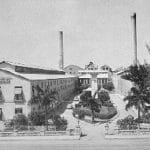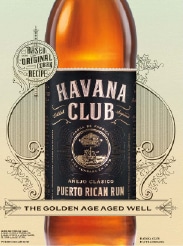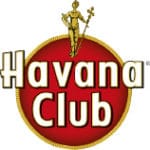In less than a quarter of a century, Havana Club has become one of the three leading rum brands globally, just behind Bacardi and Captain Morgan, despite the American embargo that prevents it from entering the world’s largest rum market. But outside of Cuba, who really knew about the existence of this brand before Pernod Ricard partnered up with the corporation Cuba Ron in December 1993?
The End of Prohibition
The Havana Club brand actually first appeared on 19 March 1934 “following meticulous preparation and market research, introducing a new industry” within the sugar-producing group Arachebala: la Fabrica de Licores. “The site was solemnly blessed by the Cuban Church, and then a new product of supreme quality appeared throughout the [Cuban] republic: the Ron Havana Club – Arechabala.” This is the story recounted in a now rare book published in 1954 to celebrate the JASA society’s 75 year anniversary.
The group José Arechabala SA (JASA), founded in 1878 in Cárdenas, is a sugar refinery factory which has incorporated, since its beginnings, a distillery named La Vizcaya in reference to the region where its founder was born. As the proclaimed oldest and largest distillery in the country before the Cuban revolution, it produced both ron in a triple column still (distillation, rectification and dehydration) and aguardiente in a single column still. It also produced pure ethanol, which has been used as fuel since 1932 to ensure the country’s autonomy in terms of energy (alcohol from molasses took on a strategic importance during the Second World War). The buildings, renamed Ronera Cárdenas, now belong to Cuba Ron, who produce the Havana Club rums, but also Santiago de Cuba (in Santiago), Arecha, Cubay, Perla del Norte, Legendario, as well as the limited editions Siglo y Medio, Isla del Tesoro and Santiago de Cuba 500, and let’s not forget the very popular aguardiente Sao Can.
High Ambitions
In the aforementioned book, we also learn that the company’s offices and a private bar were installed in 1935 in the Palacio del Conde de Casa Bayona, right in the heart of old Havana, just opposite the cathedral! As Bacardi opted to modernise by constructing an expensive art-deco style building (the largest in the capital in 1930), which also included a private bar, the industrialist Arechabla took the opposite route by renovating one of the oldest buildings in the city, built in 1720. At the time, Havana Club rum was even served at ship launchings.
It was just after American Prohibition that this brand, with an English rather than Spanish spelling (Havana rather than Habana), was created. As such, its intentions were clear: the huge American market, which although going through a crisis, was nevertheless beginning to rediscover rum. The brand was registered there in 1935 and its label included the following information: Havana Club Brand and Straight Cuban Rum, the latter recalling the designation Straight Bourbon Whisky, that is, a bourbon aged for at least two years in new, charred barrels. In the 1950s, the distillery’s cellars held soleras of oak barrels containing two million litres of rum that spent several years in the barrels. Rum production was temporarily centred on the US territory of Puerto Rico during the Second World War, probably to avoid customs charges, as is the case with Bacardi, who set up there in 1936. JASA boasted of recognition from around the world for their main brand of rum, whilst Ron Añejo Arechabala 75 was their local brand. Nonetheless, the trademark was not renewed in the Dominican Republic or Spain in 1955, which implies a position somewhat contrary to their claim of international success.
Nationalisation and legal battles
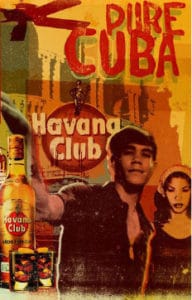
The 1993 joint venture between Cuba Ron and Pernod-Ricard demonstrated Cuba’s desire to re-establish international recognition of the brand and its previously known success. Pernod-Ricard tried to reach an agreement with the Arechabala family, who refused what was, in truth, a fairly modest offer and then approached Bacardi, who rejected the brand, conscious of the complications that this new competitor represented. A long legal battle then began in the United States. In 1995, Bacardi began producing a rum, originally in the Bahamas, under the name Havana Club™. There were therefore two brands in existence, one in the United States being used by Bacardi, and another in the rest of the world, used by Havana Club International. The Bacardi product was retracted from the market in 1997.
Revived competition
In 2006, Havana Club™ was reintroduced in Florida, home to a large Cuban community, in the form of a white rum produced in Puerto Rico by Barcardí, using the Arechabala family’s recipe. In 2013, to mark twenty years of the joint venture between Cuba Ron and Pernod Ricard, another Cuban brand was registered in the United States, Havanista, in case the embargo would soon be lifted. When President Obama visited Cuba, he followed in the footsteps of Hemingway. He probably enjoyed a mojito, but there is no actual proof; the photo that was going around social media was a fake. Cubans also savoured this moment, but some weeks later, in June 2016, Bacardi presented the new packaging for its Havana Club™ brand and its two versions; Añejo Blanco and Añejo Classico, which would be available in all American states from September 2016. The legal-commercial battle continues still, and if the embargo were lifted tomorrow, the Cuban brand could step into the market and provide stiff competition for the Puerto Rican rum.
Havana Saga in few dates
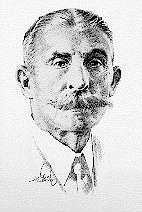
1934 – Launch of the Havana Club rum by José Arechabala SA.
1935 – Inauguration of the Havana Club offices and private bar in the historic centre of Havana and the brand’s international launch.
1955 – Non-renewal of the trademark in Spain and the Dominican Republic.
1959 – Cuban revolution.
1960 – Nationalisation of José Arechabala SA and establishment of the American embargo.
1966 – The Cuban company Cubaexport registers the brand in 80 countries, including Spain.
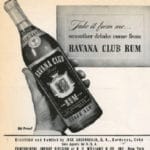
1973 – The Arechabala family do not renew the trademark Havana Club in the United States.
1974 – Ramon Arechabala goes bankrupt and tries to approach Bacardi, but nothing comes of this (according to his account in 2004).
1976 – Cuba registers the trademark with the US Patent and Trademark Office.
1991 – Dissolution of the USSR, a main export market for Cuban products.
1993 – Cuba Ron and Pernod Ricard collaborate to develop the brand internationally.
1995 – Bacardi, in association with the Arechabala family, fight the launch of the trademark in the United States and start selling a rum produced in the Bahamas under the trademark Havana Club ™.
1996 – Havana Club pursues Bacardi in court.
1997 – End of the production of Havana Club™. The American courts invalidate the Cuban trademark. Bacardi buys the Arechabala family’s shares.
1998 – The United States Congress votes on the Bacardi Bill preventing the registration of a “confiscated” trademark.
1999 – Pro-Bacardi lobbyists introduce section 211 in the law on trademarked properties. This article directly targets Havana and is nicknamed the Bacardi Bill.
2000 – The European Union takes the case to the World Trade Organisation.
2002 – Following the EU’s complaint, the WTO condemns the United States and their Bacardi Bill, but to no effect.
2006 – The renewal of the Cuban trademark (for 10 years) is refused by OFAC (Office of Foreign Assets Control) and Bacardi markets a Puerto Rican rum Havana Club™ in Florida, without having registered it.
2007 – Inauguration of a new, ultra-modern Havana Club distillery in San José de las Lajas, close to Havana.
2013 –Havana Club registers the brand Havanista in the United States.
2016 – President Obama visits Cuba. The Franco-Cuban associates manage to renew the Havana Club trademark in the United States until 2026. Bacardi remakes the packaging for its Puerto Rican Havana Club™ and launches two versions across the whole of the US market.



